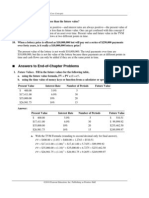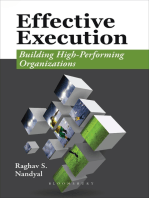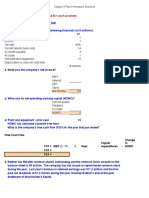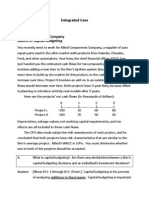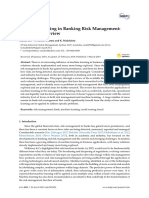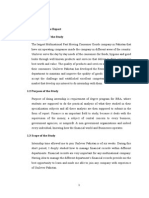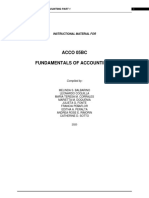The Basics of Capital Budgeting: Solutions To End-of-Chapter Problems
Uploaded by
Rand S. Al-akamThe Basics of Capital Budgeting: Solutions To End-of-Chapter Problems
Uploaded by
Rand S. Al-akamChapter 11
The Basics of Capital Budgeting
Solutions to End-of-Chapter Problems
11-7 a. Project A:
CF0 = -6000; CF1-5 = 2000; I/YR = 14.
Solve for NPVA = $866.16. IRRA = 19.86%.
MIRR calculation:
0 1 2 3 4 5
| | | | | |
-6,000 2,000 2,000 2,000 2,000 2,000
1.14
2,280.00
(1.14)2
2,599.20
(1.14)3
2,963.09
(1.14)4
3,377.92
13,220.21
Using a financial calculator, enter N = 5; PV = -6000; PMT = 0; FV = 13220.21; and solve for
MIRRA = I/YR = 17.12%.
Payback calculation:
0 1 2 3 4 5
| | | | | |
-6,000 2,000 2,000 2,000 2,000 2,000
Cumulative CF: -6,000 -4,000 -2,000 0 2,000 4,000
Regular PaybackA = 3 years.
Discounted payback calculation:
0 1 2 3 4 5
| | | | | |
-6,000 2,000 2,000 2,000 2,000 2,000
Discounted CF: -6,000 1,754.39 1,538.94 1,349.94 1,184.16 1,038.74
Cumulative CF: -6,000 -4,245.61 -2,706.67 -1,356.73 -172.57 866.17
Discounted PaybackA = 4 + $172.57/$1,038.74 = 4.17 years.
Project B:
CF0 = -18000; CF1-5 = 5600; I/YR = 14.
Solve for NPVB = $1,255.25. IRRB = 16.80%.
Chapter 11: The Basics of Capital Budgeting Integrated Case 1
MIRR calculation:
0 1 2 3 4 5
| | | | | |
-18,000 5,600 5,600 5,600 5,600 5,600
1.14 6,384.00
(1.14)2
7,277.76
(1.14)3
8,296.65
(1.14) 4
9,458.18
37,016.59
Using a financial calculator, enter N = 5; PV = -18000; PMT = 0; FV = 37016.59; and solve
for MIRRB = I/YR = 15.51%.
Payback calculation:
0 1 2 3 4 5
| | | | | |
-18,000 5,600 5,600 5,600 5,600 5,600
Cumulative CF: -18,000 -12,400 -6,800 -1,200 4,400 10,000
Regular PaybackB = 3 + $1,200/$5,600 = 3.21 years.
Discounted payback calculation:
0 1 2 3 4 5
| | | | | |
-18,000 5,600 5,600 5,600 5,600 5,600
Discounted CF: -18,000 4,912.28 4,309.02 3,779.84 3,315.65 2,908.46
Cumulative CF: -18,000 -13,087.72 -8,778.70 -4,998.86 -1,683.21 1,225.25
Discounted PaybackB = 4 + $1,683.21/$2,908.46 = 4.58 years.
Summary of capital budgeting rules results:
Project A Project B
NPV $866.16 $1,225.25
IRR 19.86% 16.80%
MIRR 17.12% 15.51%
Payback 3.0 years 3.21 years
Discounted payback 4.17 years 4.58 years
b. If the projects are independent, both projects would be accepted since both of their NPVs are
positive.
c. If the projects are mutually exclusive then only one project can be accepted, so the project
with the highest positive NPV is chosen. Accept Project B.
d. The conflict between NPV and IRR occurs due to the difference in the size of the projects.
Project B is 3 times larger than Project A.
2 Integrated Case Chapter 11: The Basics of Capital Budgeting
11-12 Input the appropriate cash flows into the cash flow register, and then calculate NPV at 10% and
the IRR of each of the projects:
Project S: CF0 = -1000; CF1 = 900; CF2 = 250; CF3-4 = 10; I/YR = 10. Solve for NPVS = $39.14;
IRRS = 13.49%.
Project L: CF0 = -1000; CF1 = 0; CF2 = 250; CF3 = 400; CF4 = 800; I/YR = 10. Solve for NPVL =
$53.55; IRRL = 11.74%.
Since Project L has the higher NPV, it is the better project, even though its IRR is less than
Project S’s IRR. The IRR of the better project is IRRL = 11.74%.
Integrated Case
11-24
Allied Components Company
Basics of Capital Budgeting
You recently went to work for Allied Components Company, a supplier of auto
repair parts used in the after-market with products from Daimler, Chrysler,
Ford, and other automakers. Your boss, the chief financial officer (CFO), has
just handed you the estimated cash flows for two proposed projects. Project L
involves adding a new item to the firm’s ignition system line; it would take
some time to build up the market for this product, so the cash inflows would
increase over time. Project S involves an add-on to an existing line, and its cash
flows would decrease over time. Both projects have 3-year lives, because Allied
is planning to introduce entirely new models after 3 years.
Here are the projects’ net cash flows (in thousands of dollars):
0 1 2 3
| | | |
Project L -100 10 60 80
Project S -100 70 50 20
Depreciation, salvage values, net working capital requirements, and tax
effects are all included in these cash flows.
Chapter 11: The Basics of Capital Budgeting Integrated Case 3
The CFO also made subjective risk assessments of each project, and he
concluded that both projects have risk characteristics that are similar to the
firm’s average project. Allied’s WACC is 10%. You must determine whether
one or both of the projects should be accepted.
A. What is capital budgeting? Are there any similarities between a firm’s
capital budgeting decisions and an individual’s investment decisions?
Answer: [Show S11-1 through S11-3 here.] Capital budgeting is the process
of analyzing additions to fixed assets. Capital budgeting is important
because, more than anything else, fixed asset investment decisions
chart a company’s course for the future. Conceptually, the capital
budgeting process is identical to the decision process used by
individuals making investment decisions. These steps are involved:
1. Estimate the cash flows—interest and maturity value or
dividends in the case of bonds and stocks, operating cash flows
in the case of capital projects.
2. Assess the riskiness of the cash flows.
3. Determine the appropriate discount rate, based on the riskiness
of the cash flows and the general level of interest rates. This is
called the project cost of capital in capital budgeting.
4. Find (a) the PV of the expected cash flows and/or (b) the
asset’s rate of return.
5. If the PV of the inflows is greater than the PV of the outflows
(the NPV is positive), or if the calculated rate of return (the IRR)
is higher than the project cost of capital, accept the project.
4 Integrated Case Chapter 11: The Basics of Capital Budgeting
B. What is the difference between independent and mutually exclusive
projects? Between projects with normal and nonnormal cash flows?
Answer: [Show S11-4 and S11-5 here.] Projects are independent if the cash
flows of one are not affected by the acceptance of the other.
Conversely, two projects are mutually exclusive if acceptance of
one impacts adversely the cash flows of the other; that is, at most
one of two or more such projects may be accepted. Put another
way, when projects are mutually exclusive it means that they do
the same job. For example, a forklift truck versus a conveyor
system to move materials, or a bridge versus a ferry boat.
Projects with normal cash flows have outflows, or costs, in the
first year (or years) followed by a series of inflows. Projects with
nonnormal cash flows have one or more outflows after the inflow
stream has begun. Here are some examples:
Inflow (+) or Outflow (-) in Year
0 1 2 3 4 5
Normal - + + + + +
- - + + + +
- - - + + +
Nonnormal - + + + + -
- + + - + -
+ + + - - -
C. (1) Define the term net present value (NPV). What is each project’s NPV?
Answer: [Show S11-6 through S11-8 here.] The net present value (NPV) is
simply the sum of the present values of a project’s cash flows:
N
CFt
NPV = (1 WACC)
t 0
t .
Project L’s NPV is $18.79:
Chapter 11: The Basics of Capital Budgeting Integrated Case 5
0 1 2 3
| 10% | | |
-100.00 10 60 80
9.09 1/1.10
1/(1.10)2
49.59
1/(1.10)3
60.11
18.79 = NPVL
NPVs are easy to determine using a calculator with an NPV function.
Enter the cash flows sequentially, with outflows entered as
negatives; enter the WACC; and then press the NPV button to obtain
the project’s NPV, $18.78 (note the penny rounding difference). The
NPV of Project S is NPVS = $19.98.
C. (2) What is the rationale behind the NPV method? According to NPV,
which project(s) should be accepted if they are independent?
Mutually exclusive?
Answer: [Show S11-9 here.] The rationale behind the NPV method is
straightforward: If a project has NPV = $0, then the project
generates exactly enough cash flows (1) to recover the cost of the
investment and (2) to enable investors to earn their required rates
of return (the opportunity cost of capital). If NPV = $0, then in a
financial (but not an accounting) sense, the project breaks even. If
the NPV is positive, then more than enough cash flow is generated,
and conversely if NPV is negative.
Consider Project L’s cash inflows, which total $150. They are
sufficient (1) to return the $100 initial investment, (2) to provide
investors with their 10% aggregate opportunity cost of capital, and
(3) to still have $18.78 left over on a present value basis. This
$18.78 excess PV belongs to the shareholders—the debtholders’
claims are fixed—so the shareholders’ wealth will be increased by
6 Integrated Case Chapter 11: The Basics of Capital Budgeting
$18.78 if Project L is accepted. Similarly, Allied’s shareholders gain
$19.98 in value if Project S is accepted.
If Projects L and S are independent, then both should be
accepted, because both add to shareholders’ wealth, hence to the
stock price. If the projects are mutually exclusive, then Project S
should be chosen over L, because S adds more to the value of the firm.
C. (3) Would the NPVs change if the WACC changed? Explain.
Answer: The NPV of a project is dependent on the WACC used. Thus, if the
WACC changed, the NPV of each project would change. NPV
declines as WACC increases, and NPV rises as WACC falls.
D. (1) Define the term internal rate of return (IRR). What is each
project’s IRR?
Answer: [Show S11-10 here.] The internal rate of return (IRR) is that
discount rate which forces the NPV of a project to equal zero:
0 1 2 3
| | | |
CF0 CF1 CF2 CF3
PVCF1
PVCF2
PVCF3
0 = Sum of PVs = NPV.
Expressed as an equation, we have:
N
CFt
IRR: (1 IRR)
t 0
t = $0 = NPV.
Note that the IRR equation is the same as the NPV equation, except
that to find the IRR the equation is solved for the particular
discount rate, IRR, which forces the project’s NPV to equal zero
Chapter 11: The Basics of Capital Budgeting Integrated Case 7
(the IRR) rather than using the WACC in the denominator and
finding NPV. Thus, the two approaches differ in only one respect:
In the NPV method, a discount rate is specified (the project’s
WACC) and the equation is solved for NPV, while in the IRR method,
the NPV is specified to equal zero and the discount rate (IRR) that
forces this equality is found.
Project L’s IRR is 18.1%:
0 1 2 3
| 18.1% | | |
-100.00 10 60 80
8.47 1/1.181
1/(1.181)
2
43.02
1/(1.181)
3
48.57
0.06 $0 if IRRl = 18.1% is used as the discount rate.
Therefore, IRRL ≈ 18.1%.
A financial calculator is extremely helpful when calculating IRRs.
The cash flows are entered sequentially, and then the IRR button is
pressed. For Project S, IRRS ≈ 23.6%. Note that with many
calculators, you can enter the cash flows into the cash flow register,
also enter WACC = I/YR, and then calculate both NPV and IRR by
pressing the appropriate buttons.
D. (2) How is the IRR on a project related to the YTM on a bond?
Answer: [Show S11-11 here.] The IRR is to a capital project what the YTM
is to a bond—it is the expected rate of return on the project, just as
the YTM is the promised rate of return on a bond.
D. (3) What is the logic behind the IRR method? According to IRR, which
projects should be accepted if they are independent? Mutually
exclusive?
8 Integrated Case Chapter 11: The Basics of Capital Budgeting
Answer: [Show S11-12 here.] IRR measures a project’s profitability in the
rate of return sense: If a project’s IRR equals its cost of capital, then
its cash flows are just sufficient to provide investors with their
required rates of return. An IRR greater than WACC implies an
economic profit, which accrues to the firm’s shareholders, while an
IRR less than WACC indicates an economic loss, or a project that will
not earn enough to cover its cost of capital.
Projects’ IRRs are compared to their costs of capital, or hurdle
rates. Since Projects L and S both have a hurdle rate of 10%, and
since both have IRRs greater than that hurdle rate, both should be
accepted if they are independent. However, if they are mutually
exclusive, Project S would be selected, because it has the higher
IRR.
D. (4) Would the projects’ IRRs change if the WACC changed?
Answer: IRRs are independent of the WACC. Therefore, neither IRRS nor
IRRL would change if WACC changed. However, the acceptability of
the projects could change—L would be rejected if WACC were
greater than 18.1%, and S would be rejected if WACC were greater
than 23.6%.
E. (1) Draw NPV profiles for Projects L and S. At what discount rate do
the profiles cross?
Answer: [Show S11-13 and S11-14 here.] The NPV profiles are plotted in
the figure below. Note the following points:
1. The Y-intercept is the project’s NPV when WACC = 0%. This is
$50 for L and $40 for S.
Chapter 11: The Basics of Capital Budgeting Integrated Case 9
2. The X-intercept is the project’s IRR. This is 18.1% for L and
23.6% for S.
3. NPV profiles are curves rather than straight lines. To see this,
note that these profiles approach cost = -$100 as WACC
approaches infinity.
4. From the figure below, it appears that the crossover rate is
between 8% and 9%.
NPV
($)
50
Project L
40
Crossover Rate 9%
30
Project S
20
IRRS = 23.6%
10
0
5 10 15 20 25 WACC (%)
-10 IRRL = 18.1%
WACC NPVL NPVS
0% $50 $40
5 33 29
10 19 20
15 7 12
20 (4) 5
E. (2) Look at your NPV profile graph without referring to the actual NPVs
and IRRs. Which project(s) should be accepted if they are
independent? Mutually exclusive? Explain. Are your answers
correct at any WACC less than 23.6%?
Answer: [Show S11-15 here.] The NPV profiles show that the IRR and NPV
criteria lead to the same accept/reject decision for any independent
project. Consider Project L. It intersects the X-axis at its IRR,
18.1%. According to the IRR rule, L is acceptable if WACC is less
10 Integrated Case Chapter 11: The Basics of Capital Budgeting
than 18.1%. Also, at any WACC less than 18.1%, L’s NPV profile
will be above the X-axis, so its NPV will be greater than $0. Thus,
for any independent project, NPV and IRR lead to the same
accept/reject decision.
Now assume that L and S are mutually exclusive. In this case, a
conflict might arise. First, note that IRRS = 23.6% > 18.1% = IRRL.
Therefore, regardless of the size of WACC, Project S would be ranked
higher by the IRR criterion. However, the NPV profiles show that
NPVL > NPVS if WACC is less than the crossover rate. Therefore, for
any WACC less than the crossover rate, say WACC = 7%, the NPV
rule says choose L, but the IRR rule says choose S. Thus, if WACC is
less than the crossover rate, a ranking conflict occurs.
F. (1) What is the underlying cause of ranking conflicts between NPV and IRR?
Answer: [Show S11-16 here.] For normal projects’ NPV profiles to cross,
one project must have both a higher vertical axis intercept and a
steeper slope than the other. A project’s vertical axis intercept
typically depends on (1) the size of the project and (2) the size and
timing pattern of the cash flows—large projects, and ones with
large distant cash flows, would generally be expected to have
relatively high vertical axis intercepts. The slope of the NPV profile
depends entirely on the timing pattern of the cash flows—long-term
projects have steeper NPV profiles than short-term ones. Thus, we
conclude that NPV profiles can cross in two situations: (1) when
mutually exclusive projects differ in scale (or size) and (2) when
the projects’ cash flows differ in terms of the timing pattern of their
cash flows (as for Projects L and S).
Chapter 11: The Basics of Capital Budgeting Integrated Case 11
F. (2) What is the reinvestment rate assumption, and how does it affect
the NPV versus IRR conflict?
Answer: [Show S11-17 here.] The underlying cause of ranking conflicts is the
reinvestment rate assumption. All DCF methods implicitly assume
that cash flows can be reinvested at some rate, regardless of what is
actually done with the cash flows. Discounting is the reverse of
compounding. Since compounding assumes reinvestment, so does
discounting. NPV and IRR are both found by discounting, so they
both implicitly assume some discount rate. Inherent in the NPV
calculation is the assumption that cash flows can be reinvested at
the project’s cost of capital, while the IRR calculation assumes
reinvestment at the IRR rate.
F. (3) Which method is the best? Why?
Answer: Whether NPV or IRR gives better rankings depends on which has
the better reinvestment rate assumption. Normally, the NPV’s
assumption is better. The reason is as follows: A project’s cash
inflows are generally used as substitutes for outside capital, that is,
projects’ cash flows replace outside capital and, hence, save the
firm the cost of outside capital. Therefore, in an opportunity cost
sense, a project’s cash flows are reinvested at the cost of capital.
Note, however, that NPV and IRR always give the same
accept/reject decisions for independent projects, so IRR can be used
just as well as NPV when independent projects are being evaluated.
The NPV versus IRR conflict arises only if mutually exclusive projects
are involved.
12 Integrated Case Chapter 11: The Basics of Capital Budgeting
G. (1) Define the term modified IRR (MIRR). Find the MIRRs for Projects L
and S.
Answer: [Show S11-18 and S11-19 here.] MIRR is that discount rate which
equates the present value of the terminal value of the inflows,
compounded at the cost of capital, to the present value of the costs.
Here is the setup for calculating Project L’s modified IRR:
0 1 2 3
WACC = 10%
| | | |
PV of costs = (100.00) 10 60 80.00
1.10
66.00
(1.10)
2
12.10
TV of inflows = 158.10
PV of TV = 100.00 MIRR = ?
$158.10
$100 =
(1 MIRR ) 3
N
PV costs = TV N
COFt CIF (1 r )
t
N t
.
(1 MIRR )N t 0 (1 WACC ) t
t 1
(1 MIRR ) N
After you calculate the TV, enter N = 3, PV = -100, PMT = 0, FV =
158.1, and then press I/YR to get the answer, MIRRL = 16.5%. We
could calculate MIRRS similarly: MIRRS = 16.9%. Thus, Project S is
ranked higher than L. This result is consistent with the NPV
decision.
G. (2) What are the MIRR’s advantages and disadvantages vis-à-vis the
NPV?
Answer: [Show S11-20 here.] MIRR does not always lead to the same
decision as NPV when mutually exclusive projects are being
considered. In particular, small projects often have a higher MIRR,
but a lower NPV, than larger projects. Thus, MIRR is not a perfect
Chapter 11: The Basics of Capital Budgeting Integrated Case 13
substitute for NPV, and NPV remains the single best decision rule.
However, MIRR is superior to the regular IRR, and if a rate of
return measure is needed, MIRR should be used.
Business executives agree. Business executives prefer to
compare projects’ rates of return to comparing their NPVs. This is
an empirical fact. As a result, financial managers are substituting
MIRR for IRR in their discussions with other corporate executives.
This fact was brought out in the October 1989 FMA meetings,
where executives from Du Pont, Hershey, and Ameritech, among
others, all reported a switch from IRR to MIRR.
H. (1) What is the payback period? Find the paybacks for Projects L and S.
Answer: [Show S11-21 through S11-23 here.] The payback period is the
expected number of years required to recover a project’s cost. We
calculate the payback by developing the cumulative cash flows as
shown below for Project L (in thousands of dollars):
Expected NCF
Year Annual Cumulative
0 ($100) ($100)
1 10 (90)
2 60 (30) Payback is between
3 80 50 t = 2 and t = 3
0 1 2 3
| | | |
-100 10 60 80
-90 -30 50
Project L’s $100 investment has not been recovered at the end of
Year 2, but it has been more than recovered by the end of Year 3.
Thus, the recovery period is between 2 and 3 years. If we assume
that the cash flows occur evenly over the year, then the investment
14 Integrated Case Chapter 11: The Basics of Capital Budgeting
is recovered $30/$80 = 0.375 ≈ 0.4 into Year 3. Therefore,
PaybackL = 2.4 years. Similarly, PaybackS = 1.6 years.
H. (2) What is the rationale for the payback method? According to the
payback criterion, which project(s) should be accepted if the firm’s
maximum acceptable payback is 2 years, if Projects L and S are
independent, if Projects L and S are mutually exclusive?
Answer: Payback represents a type of “breakeven” analysis: The payback
period tells us when the project will break even in a cash flow
sense. With a required payback of 2 years, Project S is acceptable,
but Project L is not. Whether the two projects are independent or
mutually exclusive makes no difference in this case.
H. (3) What is the difference between the regular and discounted payback
methods?
Answer: [Show S11-24 here.] Discounted payback is similar to payback
except that discounted rather than raw cash flows are used.
Optional Question
What is Project L’s discounted payback, assuming a 10% cost of capital?
Answer: Expected Net Cash Flows
Year Raw Discounted Cumulative
0 ($100) ($100.00) $100.00)
1 10 9.09 (90.91)
2 60 49.59 (41.32)
3 80 60.11 18.79
Discounted paybackL = 2 + ($41.32/$60.11) = 2.69 = 2.7 years.
Versus 2.4 years for the regular payback.
Chapter 11: The Basics of Capital Budgeting Integrated Case 15
H. (4) What are the two main disadvantages of discounted payback? Is the
payback method of any real usefulness in capital budgeting decisions?
Explain.
Answer: Regular payback has three critical deficiencies: (1) It ignores the
time value of money. (2) It ignores the cash flows that occur after
the payback period. (3) Unlike the NPV, which tells us by how much
the project should increase shareholder wealth, and the IRR, which
tells us how much a project yields over the cost of capital, the
payback merely tells us when we get our investment back.
Discounted payback does consider the time value of money, but it
still fails to consider cash flows after the payback period and it
gives us no specific decision rule for acceptance; hence, it has 2
basic flaws. In spite of its deficiency, many firms today still
calculate the discounted payback and give some weight to it when
making capital budgeting decisions. However, payback is not
generally used as the primary decision tool. Rather, it is used as a
rough measure of a project’s liquidity and riskiness.
I. As a separate project (Project P), the firm is considering sponsoring
a pavilion at the upcoming World’s Fair. The pavilion would cost
$800,000, and it is expected to result in $5 million of incremental
cash inflows during its 1 year of operation. However, it would then
take another year, and $5 million of costs, to demolish the site and
return it to its original condition. Thus, Project P’s expected net
cash flows look like this (in millions of dollars):
0 1 2
| | |
-0.8 5.0 -5.0
16 Integrated Case Chapter 11: The Basics of Capital Budgeting
The project is estimated to be of average risk, so its WACC is 10%.
I. (1) What is Project P’s NPV? What is its IRR? Its MIRR?
Answer: [Show S11-25 here.] Here is the time line for the cash flows, and
the NPV:
0 1 2
10%
| | |
-800,000 5,000,000 -5,000,000
NPVP = -$386,776.86.
We can find the NPV by entering the cash flows into the cash flow
register, entering I/YR = 10, and then pressing the NPV button.
However, calculating the IRR presents a problem. With the cash
flows in the register, press the IRR button. An HP-10BII financial
calculator will give the message “error-soln.” This means that
Project P has multiple IRRs. An HP-17BII will ask for a guess. If
you guess 10%, the calculator will show IRR = 25%. If you guess
a high number, such as 200%, it will show the second IRR, 400%.1
The MIRR of Project P = 5.6%, and is found by calculating the
discount rate that equates the terminal value ($5.5 million) to the
present value of costs ($4.93 million).
I. (2) Draw Project P’s NPV profile. Does Project P have normal or
nonnormal cash flows? Should this project be accepted? Explain.
Answer: [Show S11-26 through S11-28 here.] You could put the cash flows
in your calculator and then enter a series of I/YR values, get an
NPV for each, and then plot the points to construct the NPV profile.
We used a spreadsheet model to automate the process and then to
1 Looking at the figure below, if you guess an IRR to the left of the peak NPV rate, the lower
IRR will appear. If you guess IRR > peak NPV rate, the higher IRR will appear.
Chapter 11: The Basics of Capital Budgeting Integrated Case 17
draw the profile. Note that the profile crosses the X-axis twice, at
25% and at 400%, signifying two IRRs. Which IRR is correct? In
one sense, they both are—both cause the project’s NPV to equal
zero. However, in another sense, both are wrong—neither has any
economic or financial significance.
Project P has nonnormal cash flows; that is, it has more than
one change of signs in the cash flows. Without this nonnormal cash
flow pattern, we would not have the multiple IRRs.
Since Project P’s NPV is negative, the project should be
rejected, even though both IRRs (25% and 400%) are greater than
the project’s 10% WACC. The MIRR of 5.6% also supports the
decision that the project should be rejected.
NPV
(Thousands of Dollars)
500
375
250
125
0
100 200 300 400 500
r (%)
-125
-250
-375
18 Integrated Case Chapter 11: The Basics of Capital Budgeting
You might also like
- Lifecycle Investing: 0465018291-Ayres - 1stpages 2/22/10 12:03 PM Page I100% (1)Lifecycle Investing: 0465018291-Ayres - 1stpages 2/22/10 12:03 PM Page I236 pages
- Carwow Carwow LTD Pitch Uk Summary of Key InformationNo ratings yetCarwow Carwow LTD Pitch Uk Summary of Key Information9 pages
- Jegan Tucker - Financial Analysis Comparison Memo Report - Draft 3 Long V 1 FinalNo ratings yetJegan Tucker - Financial Analysis Comparison Memo Report - Draft 3 Long V 1 Final7 pages
- Determinants of Interest Rates (Revilla & Sanchez)No ratings yetDeterminants of Interest Rates (Revilla & Sanchez)12 pages
- International Financial Statement AnalysisNo ratings yetInternational Financial Statement Analysis3 pages
- Effective Execution: Building High-Performing OrganizationsFrom EverandEffective Execution: Building High-Performing OrganizationsNo ratings yet
- Bank Valuation and Value Based Management: Deposit and Loan Pricing, Performance Evaluation, and Risk, 2nd EditionFrom EverandBank Valuation and Value Based Management: Deposit and Loan Pricing, Performance Evaluation, and Risk, 2nd Edition1/5 (1)
- Holly Fashions Ratio Analysis: 1. Calculate The Firm's Ratios Listed in Exhibit 3No ratings yetHolly Fashions Ratio Analysis: 1. Calculate The Firm's Ratios Listed in Exhibit 37 pages
- St-2 Net Income and Cash Flow: Chapter 3 Part II Homework SolutionsNo ratings yetSt-2 Net Income and Cash Flow: Chapter 3 Part II Homework Solutions13 pages
- Future of Mining With AI:: Building The First Steps Towards An Insight Driven OrganizationNo ratings yetFuture of Mining With AI:: Building The First Steps Towards An Insight Driven Organization9 pages
- PAGLANGAN, Jay Akbar S. - 2BSE-A - Exercise-2.3No ratings yetPAGLANGAN, Jay Akbar S. - 2BSE-A - Exercise-2.31 page
- Group Case 4 - Western Money Management Inc.No ratings yetGroup Case 4 - Western Money Management Inc.8 pages
- Bonds and Their Valuation: Key Features of Bonds Bond Valuation Measuring Yield Assessing RiskNo ratings yetBonds and Their Valuation: Key Features of Bonds Bond Valuation Measuring Yield Assessing Risk36 pages
- Consumer Markets & Consumer Buying BehaviorNo ratings yetConsumer Markets & Consumer Buying Behavior24 pages
- Time Value of Money: Future Value Present Value Annuities Rates of Return AmortizationNo ratings yetTime Value of Money: Future Value Present Value Annuities Rates of Return Amortization44 pages
- Lecture 6 - Kotler - Segmentation-Targeting - PositioningNo ratings yetLecture 6 - Kotler - Segmentation-Targeting - Positioning26 pages
- 8 Sources of Intermediate and Long-Term Financing100% (1)8 Sources of Intermediate and Long-Term Financing13 pages
- Funds Analysis, Cash-Flow Analysis, and Financial Planning100% (1)Funds Analysis, Cash-Flow Analysis, and Financial Planning31 pages
- Barclays Statement of Facts From The Justice DepartmentNo ratings yetBarclays Statement of Facts From The Justice Department23 pages
- Consumer Market and Consumer Buying BehaviorNo ratings yetConsumer Market and Consumer Buying Behavior15 pages
- Session 2 - by Catherine Rose Tumbali - PPTNo ratings yetSession 2 - by Catherine Rose Tumbali - PPT25 pages
- Crane and Matten: Business Ethics (3rd Edition)No ratings yetCrane and Matten: Business Ethics (3rd Edition)35 pages
- Option Writing (11-02-2020) - 202002111240535114872No ratings yetOption Writing (11-02-2020) - 2020021112405351148724 pages
- AGI Greenpac Ltd - Stock Update - 14.08.2023-1No ratings yetAGI Greenpac Ltd - Stock Update - 14.08.2023-113 pages
- CBSE Class 12 Business Studies Important Questions For Chapter 4 PlanningNo ratings yetCBSE Class 12 Business Studies Important Questions For Chapter 4 Planning12 pages
- Paper - 1: Principles & Practice of Accounting Questions True and FalseNo ratings yetPaper - 1: Principles & Practice of Accounting Questions True and False32 pages
- ACT1201 - Accounting For Special Transactions - Study PlanNo ratings yetACT1201 - Accounting For Special Transactions - Study Plan4 pages
- SUMMER TRAINING PROJECT REPORT ON StudyNo ratings yetSUMMER TRAINING PROJECT REPORT ON Study55 pages
- Total Assets of Jessica P4550,000 Total Liabilities Only of Jenny CoNo ratings yetTotal Assets of Jessica P4550,000 Total Liabilities Only of Jenny Co17 pages
- Lifecycle Investing: 0465018291-Ayres - 1stpages 2/22/10 12:03 PM Page ILifecycle Investing: 0465018291-Ayres - 1stpages 2/22/10 12:03 PM Page I
- Carwow Carwow LTD Pitch Uk Summary of Key InformationCarwow Carwow LTD Pitch Uk Summary of Key Information
- Jegan Tucker - Financial Analysis Comparison Memo Report - Draft 3 Long V 1 FinalJegan Tucker - Financial Analysis Comparison Memo Report - Draft 3 Long V 1 Final
- Determinants of Interest Rates (Revilla & Sanchez)Determinants of Interest Rates (Revilla & Sanchez)
- Effective Execution: Building High-Performing OrganizationsFrom EverandEffective Execution: Building High-Performing Organizations
- Bank Valuation and Value Based Management: Deposit and Loan Pricing, Performance Evaluation, and Risk, 2nd EditionFrom EverandBank Valuation and Value Based Management: Deposit and Loan Pricing, Performance Evaluation, and Risk, 2nd Edition
- Holly Fashions Ratio Analysis: 1. Calculate The Firm's Ratios Listed in Exhibit 3Holly Fashions Ratio Analysis: 1. Calculate The Firm's Ratios Listed in Exhibit 3
- St-2 Net Income and Cash Flow: Chapter 3 Part II Homework SolutionsSt-2 Net Income and Cash Flow: Chapter 3 Part II Homework Solutions
- Future of Mining With AI:: Building The First Steps Towards An Insight Driven OrganizationFuture of Mining With AI:: Building The First Steps Towards An Insight Driven Organization
- Bonds and Their Valuation: Key Features of Bonds Bond Valuation Measuring Yield Assessing RiskBonds and Their Valuation: Key Features of Bonds Bond Valuation Measuring Yield Assessing Risk
- Time Value of Money: Future Value Present Value Annuities Rates of Return AmortizationTime Value of Money: Future Value Present Value Annuities Rates of Return Amortization
- Lecture 6 - Kotler - Segmentation-Targeting - PositioningLecture 6 - Kotler - Segmentation-Targeting - Positioning
- Funds Analysis, Cash-Flow Analysis, and Financial PlanningFunds Analysis, Cash-Flow Analysis, and Financial Planning
- Barclays Statement of Facts From The Justice DepartmentBarclays Statement of Facts From The Justice Department
- Capital expenditure Complete Self-Assessment GuideFrom EverandCapital expenditure Complete Self-Assessment Guide
- Option Writing (11-02-2020) - 202002111240535114872Option Writing (11-02-2020) - 202002111240535114872
- CBSE Class 12 Business Studies Important Questions For Chapter 4 PlanningCBSE Class 12 Business Studies Important Questions For Chapter 4 Planning
- Paper - 1: Principles & Practice of Accounting Questions True and FalsePaper - 1: Principles & Practice of Accounting Questions True and False
- ACT1201 - Accounting For Special Transactions - Study PlanACT1201 - Accounting For Special Transactions - Study Plan
- Total Assets of Jessica P4550,000 Total Liabilities Only of Jenny CoTotal Assets of Jessica P4550,000 Total Liabilities Only of Jenny Co


